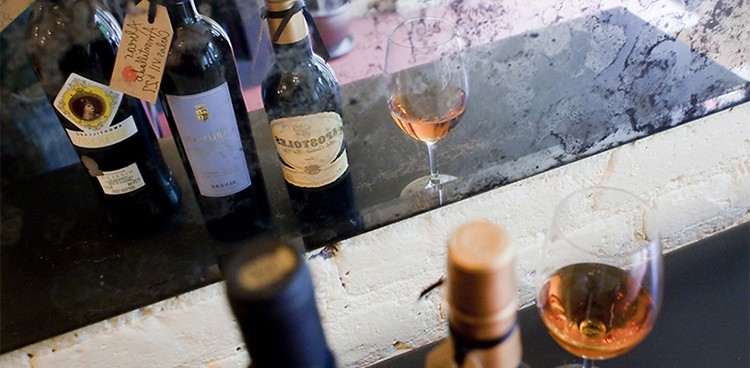
A small glass of dry Sherry and a slice of Manchego: that was the very first thing I put in my mouth when I arrived in Sevilla, Spain. It was only appropriate, since I was headed to Jerez, where this curious wine is made. But that little introduction inspired an obsession I haven’t been able to let go of since.
Sure, there was the mind-altering effect of jet lag, but it was also something about how the sharp, salty cheese—almost rich enough to leave oil on the fingers—flooded the palate with its sheepy flavor, and how the crisp wine seemed to whisk it away with the ease and delicacy of a sea breeze; the saltiness of one begged for more of the other. They seemed destined to be together. All the flavors common to Sherry—dried fruits, toasted nuts—feel natural next to cheese, more natural, in fact, than the fresh cherry, raspberry, or plum notes of a red wine. And with their powerful acidity and heightened alcohol (most run 15 to 18 percent), Sherries are also particularly effective at cleansing the palate.
The problem, of course, is getting a grip on Sherry. It’s unusual stuff in the wine world, no doubt about it. Sherry-style wines are made all over the world, but the real stuff comes only from Jerez de la Frontera, a sunny, warm spot on Spain’s southern coast. Here, winemakers purposely expose their wines to air by filling their wine barrels only partway. In the headspace, many wines develop flor, a thick, white blanket of yeast. This “veil” partly protects the wine from oxygen; it also adds its own particular tang to the wine. The result is a Fino Sherry: a light-colored, bracingly sharp, sea-scented white with bright, refreshing acidity. (Just to confuse matters, if the wine was aged in bodegas in Sanlúcar de Barrameda, right on the coast, the Fino is called a Manzanilla; it tends to be lighter and saltier than its inland brethren.)
Sometimes the flor dies, and air is allowed to oxidize the wine. These darker, nuttier wines are called either Palo Cortado or Amontillado, depending on how they age. Both feel richer than Finos yet still retain a crisp dryness. Locals think these are the most versatile styles of Sherry; they’ll drink them with anything from raw seafood to seared red meat.
When the flor doesn’t develop at all, you get an Oloroso. These golden brown wines can be dry or sweet (the latter usually marked “dulce”), but even the dry ones often give an impression of sweetness due to their concentration—they feel even thicker than the aforementioned Sherries, with plenty of dried fruit and nut flavors.
Lastly, there are the seriously sweet Sherries, like cream Sherries, or PX wines, which technically aren’t Sherries of the region but are grown nearby. Some of these, particularly old examples, can be so thick that they are best applied to the tongue with an eyedropper—or drizzled over a chunk of blue.
Choosing for Cheese
So where to start when building a cheese course around Sherry? I asked Kerin Auth, the manager of Tinto Fino, an all-Spanish wine store in New York’s East Village as well as a teacher at Murray’s Cheese and the Artisanal Cheese Center, both in New York City. She immediately starts at the sweet end of the spectrum, explaining that, in her experience, these are the gateway Sherries. “A lot of people don’t like blue cheeses, but I find I can convert them with a sweet Sherry,” she says. “And many people think they don’t like Sherry, until they taste one of these with a blue.” She also might reduce the wine in a saucepan until it gets thick and figgy and then use it as a condiment, drizzling it over a chunk of cheese or even steak with blue cheese. It’s also an excellent ingredient in a vinaigrette for a goat cheese salad. Auth will drink it straight, but she warns that a modicum of caution is in order: “If you have a very rich, creamy cheese—the triple crèmes, for example—a sweet Sherry is just too much,” she says. Instead, she looks for a drier cheese (a crumbly Valdeón would do well) to set off the lusciousness of the wine. “It’s a little like jam and peanut butter—you need the jam to help the peanut butter go down.”
For sheer versatility, however, Auth looks to dry Olorosos and Amontillados. “They have a little more fruit than the Finos, which makes them easier to work with, but they aren’t as rich as the sweet ones. Try a cheese like Mahon, or even a Gouda or other aged cow’s milk cheese with an Amontillado: you get that little bit of crystallization in the cheese, an almost crumbly texture against the rich nuttiness of the Sherry—it’s fabulous.” These wines can also handle the tang of goat cheese. “Check them out with Cabra Romero,” she suggests, referring to a rosemary-covered goat round, “or Garroxta. Goaty, creamier cheeses go really well with Amontillados.”
As for Fino, there’s a reason Manchego and Fino is a classic pairing: Manchego is one of the few cheeses that has the right balance for Fino’s cutting acidity and bone-dry, salty flavor, Auth says. “Some Finos can be hard to pair because they are so dry and salty; Manzanillas are actually even harder because they are saltier than regular Finos,” she says. “But these can work well with strong, dry cheeses; for instance, a Fino cuts the smoke of Idiazabal really well.” A sheepy Roncal would work well, too—anything firm and a little fruity, with a strong personality.
“One of the many great things about Sherries,” Auth adds, “is that because they are already oxidized, they don’t change much once they are opened; you can keep them in the fridge for a couple of weeks after opening and play with them over time.” Just add cheese, and the flavor game begins.
A dozen Sherries to get you started:
- El Maestro Sierra Fino, $19
- Gutierrez Colosia Elcano Fino, $13
- Pedro Romero Fino, $15
- Emilio Lustau Palo Cortado, $28
- González Byass Jerez-Xeres-Sherry Apóstoles Palo Cortado Muy Viejo, $45
- Pedro Romero Amontillado, $13
- Dios Baco Amontillado, $18
- El Maestro Sierra Amontillado, $32
- González Byass Solera 1847 Oloroso Dulce, $18
- Emilio Hidalgo Morenita Cream, $14
- Alvear 1927 PX, $23
- Pedro Romero Moscatel, $15





